 Go
to the Archive index
Go
to the Archive indexStrange how many stories seem to start at the 1955 Earls Court Motor Cycle Show! So, here we are again, weaving our way through the crowds to the aroma of damp Gaberdine coats and wafting Woodbines. Picking a route through the stands on the hall plan, down the aisle between Ambassador (166) and Dayton (158), Gilera on the left, then AC (163) showing the Petite 3-wheeler, straight ahead DOT (161) ... Ah, here we are, to the right, stand 159, Aberdale & Bown - where our tale continues from the last edition! Just in time to catch the launch of their new moped. Oh dear, someone must have thought it needed a nice catchy alliterated model name like the other manufacturers: Norman Nippy, Mercury Mercette ... but lettered along the front number plate, the Bown "Bambi"! Maybe a tribute to the Walt Disney animated film of 1942? A name one feels that may not prove to be particularly appealing to the motor cycling public! Fortunately the Bambi name was very quickly dropped and the machine simply became known as The Bown 50.
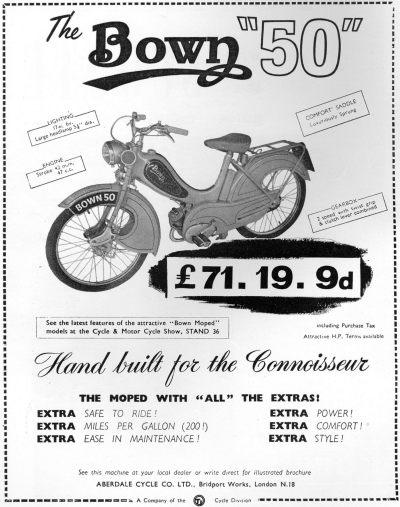
Original publicity material
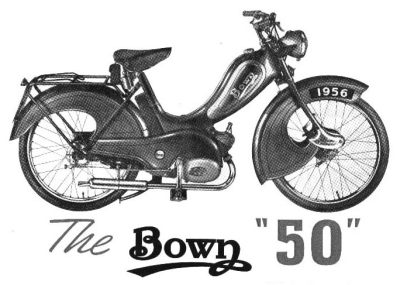
With the Welsh site closed in December 1954, the address on the literature may have returned to London, but the mopeds were actually coming from Aberdale's huge new manufacturing plant ... in Germany! This other factory really was a vast leviathan, but more commonly known to everyone else as Fichtel & Sachs! Sachs 2-speed engine, Sachs hubs, Aberdale had taken to the factored option and the Bown moped was being widely sold across the rest of Europe under the German Hercules brand, Prior, and TWN (Triumph Werke Nürnberg) as Fips models.
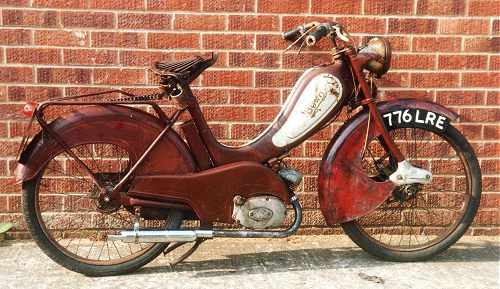
A Bown 50 in original condition, with the Sachs engine.
From the vast resources of the Zweirad Union, a customer could pick and mix pretty much any moped parts they fancied to achieve a personalised brand model, and the trailing link forks appeared to have been taken from the group's Pantherwerke Bobby 5. The Bown literature said "British built", but British assembled was more like it; you certainly needed to look pretty closely to find the Aberdale contributions! The rims were Dunlop, suggesting they built up the wheels and fitted the tyres, while the rear rack style with its parcel clip and mounting for number plate never appeared on any continental variants so presumably was also made up over here. Steering head bearings were Bayliss & Thomas (Excelsior), the handlebar assembly, cycle saddle and Miller electrical set are other typical British market fittings, so it seems likely the machines came in as components to be painted (initially maroon & white or light blue & dark blue, then other combinations later) and assembled at the Aberdale works in Edmonton. Initially the machine was grossly overpriced and sold poorly, but after some compromise on the profit margin, did find steady if unspectacular sales. General quality was good, but the front forks were prone to fracture.
The original rigid machine was joined in March 1957 by a further Spring Heel model with plunger rear suspension. Aberdale built-out the last bikes in 1958, but with many of these still looking for buyers, both models re-appeared on early listings for 1959. Then that was it, end of story, Bown was gone, finished, never to be seen again ... but what if? What if they'd gone on a little longer?
By July of 1959, over at Phillips and Norman, engineers were busy replacing their respective Rex and Sachs engine installations with the new Villiers 3K moped motor. Bown autocycles and motor cycles had previously installed Villiers engines, so if the moped had continued, like the Gadabout, Nippy and Lido, what if the Bown moped had also become installed with the 3K? Perhaps it would look something like ...
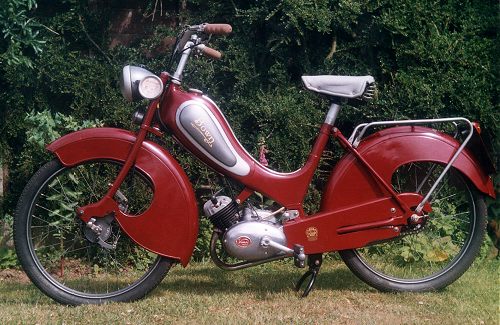
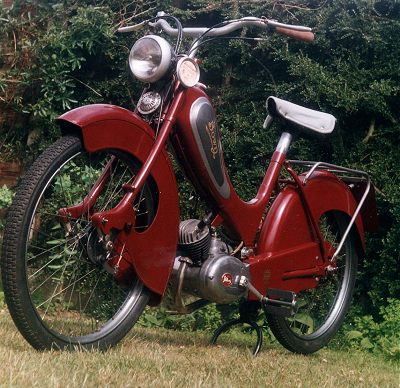
Now it's understandable if people familiar with this obscure brand think what they're seeing here is a computer-generated hallucination. Admittedly, everything looks so natural, balanced, as if it's always been like this! But the best of these such machines are always the ones that never look like what they really are - it's a Special! Today we test what might have been in 1959 if Bown had continued, and followed the course of other British moped manufacturers.
Since the Norman machines originally fitted the same Sachs motor, then adapted the Villiers by a set of engine plates, theory says you should be able to use these same plates to install the 3K motor into the Bown frame. Fine in principle, but in actual practice, not quite that simple. Because of differences in the Bown frame, significant alterations are required to all the mountings, exhaust fixing, RH rear mudguard panel, chainguard, rear brake linkage, shortening of the pedal arms by 1", and a specially made 11T front sprocket to bring the drive ratio into range with the 28T rear sprocket. (3Ks normally fit a 12T front driving 32T rear, so the ratio on the Bown is raised 7% above standard). This machine really only came about in 2003 as a result of the builder being donated the incomplete remains of a dismantled machine in a sack. With little prospect of acquiring all the missing parts for such an uncommon model, a Special became the only practical way to recover the bike.
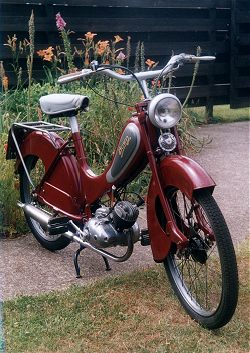
Beyond the obvious modifications, there's been further effort to de-clutter the machine with removal of toolbox brackets from the frame and the parcel clip off the rack, resulting in a cleaner look that pleasantly emphasises the natural form of the styling. Even detail like the engine cut-out is mounted down by the motor to reduce trailing wiring and avoid a second button on the handlebar. Paintwork is finished in a maroon, silver & grey metallic combination, not far from one of the original schemes.
The choke is engaged by pushing down a shutter knob on the carb, to lift off again as the throttle is opened. There is also a flood button, as a further aid in cold weather. The lack of decompressor on any 3K is a major handicap to starting, in just simply getting the pedals into kick-position, since the clutch is invariably reluctant to free when the engine is cold. Then you find the specially shortened pedal arms on this installation further reduce the leverage advantage and require quite some excessive effort to turn the motor. Once actually started, everything else feels pretty conventional, and the 2-speed gear twists into 1st with the familiar clunk. The Bown nips smartly away as you slide in the manual clutch and buzz up the revs. Bottom gear allows a maximum of 15mph, but a happy motor asks to change up around 12mph, leaving 2nd gear a big jump away, then there's a bit of a dead zone up to 20mph until the revs start to pick up again. While the original Sachs motor was rated at 1.6bhp, the 3K at 2bhp represents quite some power advantage and pulls its ratio very well. Tackling hills in the powerband usually allows you to charge up in top gear, but requires a cog back to 1st once it drops off the boil, slower but irresistible, you'll never need to pedal assist. No speedo is mounted, but top speed by the pace bike achieves 35mph on the flat with a light tailwind, and 37mph downhill, at which all the tin panelling is drumming away like a Caribbean steel band! Natural cruising speed with the current ratio is about 25mph, though the way the motor pulls its revs in top suggests it might cope with a slightly higher gear, which could also contribute to reduce high-speed vibration. The functional commuter design of the cycle chassis is emphasised by ready scraping of the low centre stand on corners, which quickly puts you off any brave manoeuvres. The rigid tail gives the rider a steady battering on rough roads, and while the saddle looks suitably period, beyond local usage returns only increasing discomfort. The back-pedal rear brake is typically effective, and while the lever operated front brake is typically ineffective, the movement of its pivoting linkage arms with the suspension action at least makes it visually interesting. The front suspension floats quite pleasantly under normal conditions, though bottoms out on larger potholes, and clatters back on the rebound.
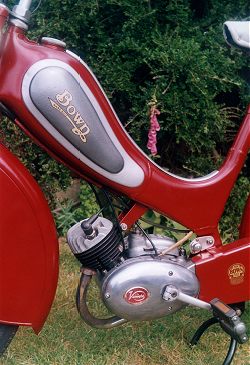
The Bown moped Special makes an interesting concept, with general opinion being that it actually looks better than the original bike! Installing the Villiers 3K/1 engine is appreciably more than a nuts and bolts job, and due to the engineering required to make a presentable machine, is really not the sort of conversion that many people are likely to tackle. Would Aberdale have produced it? Well, they could have done! Receiving the basic bike as a knock down kit, they would have only have needed to buy in fewer components from Sachs, then do a few more parts themselves, which was no different to what happened at Norman, Phillips and Raleigh. With Aberdale becoming part of Tube Investments from 1958, it's more likely they might have adopted the group telescopic fork used on the Hercules Corvette and Phillips Panda Mk2, along with matching British Hub Co Motoloy hubs and 32T rear sprocket, to utilise the Villiers factory standard 12T front sprocket. The actual installation and tinware shouldn't have presented much of a problem, and it's possible Villiers may even have forged the required shorter pedal arms at the front end of the 3K moped engine project to bring another customer on stream. The Bown frame features a low motor mounting anyway, and the 3K pedal shaft centre drops a further 1" from the Sachs position. Using the standard Villliers arms, the pedals would have been only 3" from the ground at the bottom of their stroke, which was really far too low, so the Special required these arms shortened by 1" to restore lowest clearance to a more tolerable 4".
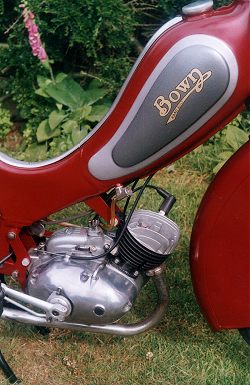
The Bown 3K Special makes an entertaining concept. It's unlikely you'll ever see another, so watch for this one on the NACC rally circuit; after all, it is unique!
Coming next - sometimes we find the most extraordinary machines turning up for the test feature. In this case, a particularly important cyclemotor, immensely rare, and not so much another road test, as the chance to actually ride a living legend! It's taken another of those epic research projects to bring you this never before published story of the first British clip-on produced following WWII, and takes us right back to the very dawn of cyclemotoring history. Dick's new engine even seemed to borrow its very name from horsepower!
First published, February 2004